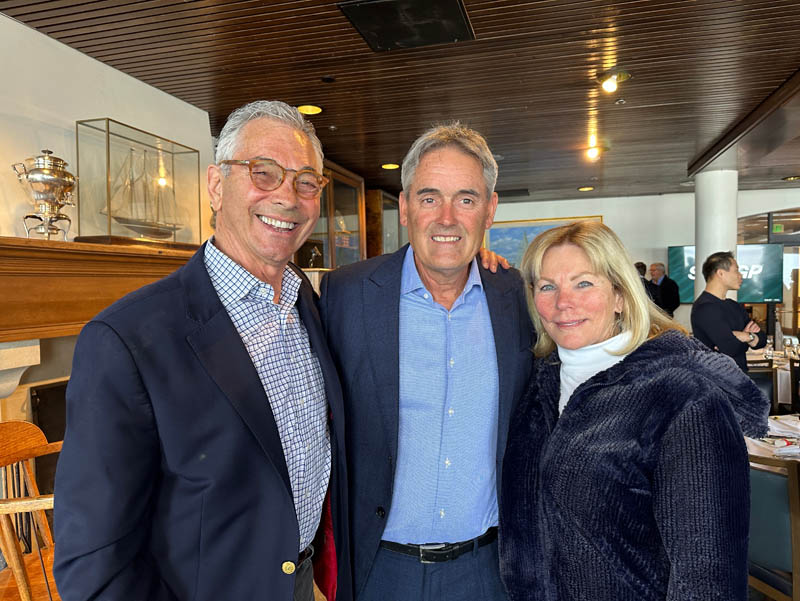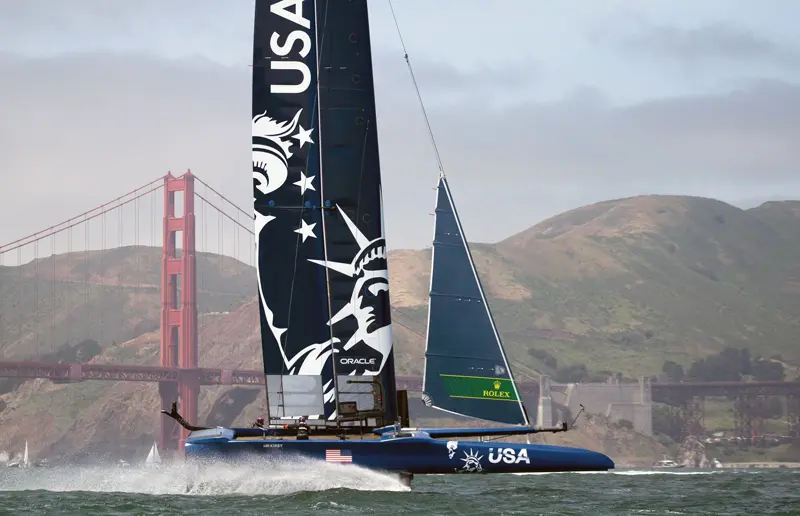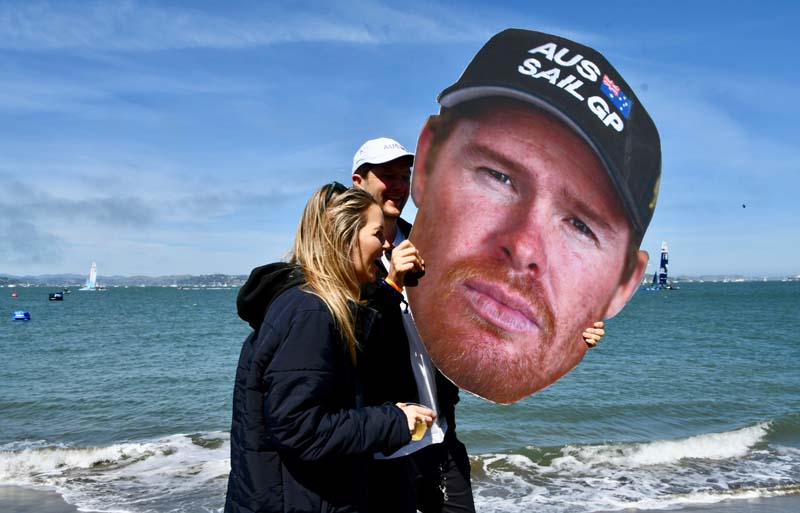
Sir Russell Coutts, SailGP and the Razor’s Edge
SailGP’s foiling catamarans can sail at about three times the speed of the wind. Top speeds are now about 54 knots. New rudders currently in production might get them to 56 knots, and future foils might get them to 60 knots. At these speeds, each crossing is a close shave. Russell Coutts, the founder and CEO of SailGP, says that’s fast enough. Sir Russell Coutts spoke at the St. Francis Yacht Club Wednesday Yachting Luncheon to give members and guests a preview and insights into this coming weekend’s SailGP Final, to be held Saturday and Sunday on the Cityfront.

SailGP league has come a long way since season one. The league has survived and thrived despite daunting hurdles. All outdoor events face weather problems, but stadium sailing on TV requires some consistent action despite the fickle nature of wind and weather and occasional crashes and calamities — like the hurricane-force winds at the Australia event that blew up much of the base.
The development of wings and foils has allowed the racing to stay on the water and maintain excitement across a broad spectrum of wind conditions. The traveling circus has learned to travel the globe with nine teams of foiling boats and assemble premier event sites at the water’s edge with increasing abilities and efficiency. And the crowds are growing. You can now view SailGP events in 200 territories.
The audience has grown into the millions and, according to Coutts, the data shows perhaps 80% of them have never stepped onto a sailboat. The average age of viewers is dropping, with an increasing number of 25- and 30-year-old viewers, plus it’s attracting an increasing number of female viewers. The event did garner some rare local attention for sailing in the general media with an article in the San Francisco Chronicle.

This all plays into a foundational thesis for SailGP that sailing needs a consistently scheduled, high-profile, expertly produced sailing event that is understandable to the masses. Somewhere along the way, the increase in spectators should convert to an increase in participants. To help the public understand, Coutts says, “We have to talk in a language that people will understand.” This brings us back to knots. Though the boats could eventually reach a top speed of 60 knots, the public won’t hear that. They’ll learn the top speed could approach 111 kilometers per hour. Talking in kph vs. knots is controversial for many sailors, but Coutts says the data shows it works, and those of us who never converted our sixth-grade metric lessons into alignment with the rest of the planet are simply out of touch. The guiding principle for commercial success is, “Are viewers interested in watching this or not?” The data is conclusive.
Staying on the edge means if the crew can fly the boat about two inches higher above the water, they can increase the speed by three to five knots. When the foil sections went from 12% to 9% they added about three knots to all the boats. If they fly a couple of inches too high the foils come out of the water and they crash. It’s a delicate balance, but to win they have to sail on the razor’s edge. In fact, the trailing edges of the foils are literally almost as sharp as a razor.
Besides the extreme speeds, the razor’s edge for the whole event is developing a commercial entertainment product that becomes a successful event business, and is sustainable without the support of its founding patron, Larry Ellison. A growing audience and a new 10-year contract with Rolex, with a 10-year option to renew, suggest the foundation is solidifying. Success has allowed the bonus pool for winning to grow to $4.3 million, including the $1 million grand prize that will be awarded on Sunday.

Many other interesting numbers and fun facts came out of the presentation. Like the rest of the world, SailGP has shifted to a more remote workforce. Race Director Ian Murray will be managing the race from his tech office in Australia, where he can oversee the whole race and remote-controlled mark positions from the office. If the wind dies and they need to shorten course he can move the marks on the Bay, from Australia. The umpires sit in an office in London. Data is collected from 800 sensors aboard the boat, so if someone claims they tried to avoid a collision the umpires can just look to see if they actually moved their rudder. Other numbers include the 32 functions needed to perform a perfect tack. And there’s the impact on youth, where SailGP has taken 14,700 young people sailing and hired 415 interns, of whom 150 have joined the sailing industry, 20 are here in San Francisco and 14 have been hired full-time by SailGP. These up-and-coming youth are 50% boys and 50% girls.
The event now claims TV sports news, and sports viewership averages just under 129 million per event, with 122.5 on mainstream news and 6.5 million in sports news and magazines. We liked hearing the mention of magazines and know our readers must be part of that number! The fourth SailGP season will have 12 events, with four in the US, including a new one at the end of July in Los Angeles Harbor. As growth continues, they’re looking toward an annual 20-event season, so fans (and sponsors) can expect to watch an event approximately every two weeks.

The competition is still all about the teams and their skippers. This weekend’s event is a chance for Tom Slingsby’s Team Australia to win their third title. Barring disaster, they and New Zealand have locked in their spots for Sunday’s $1 million winner-take-all final. Yet Team Australia did damage their wing when they flipped during a practice day, threatening their ability to race. New Zealand is in a solid second, and France and Great Britain are one point apart vying for third.
Russell Coutts is a big fan of Douglas Adams, author of Hitchhiker’s Guide to the Galaxy, whom he quoted, saying, “A learning experience is one of those things that says, ‘You know that thing you just did? Don’t do that.'” As a revered sailor, America’s Cup winner, engineer and now entrepreneur, Coutts is willing to push the razor’s edge. He’s trying new things, courting controversy, and embracing many new learning experiences. It’s very much aligned with the Silicon Valley ethos of launch, learn and iterate. Season three will end on Sunday, and season four will start shortly after in Chicago, on June 16–17.
If you’re a sailor who finds themselves sitting next to a non-sailing fan, perhaps you can help them become a participant rather than a spectator, by explaining the difference between knots and miles per hour. Then invite them sailing, letting them know your boat goes about six knots (6.9 mph / 11/kph) and is safe and relaxing.

I’m slowly coming around to foiling vessels. Admittedly I thought it to be an abomination to sailing, racing in particular due to money and tech running and usually a large part of who wins.
I was out on the water during AC Cup in ’13. As a member then of GGYC I wasnt necessarily a fan of Ellison but hey- he was biggly responsible for bringing AC to the bay. However, I’m surprised that there is so little outrage over SailGP thinking they can CHARGE folks to WATCH the race from their own private boats! We didnt do that during the Cup. We dont do it for Blue Angels. By whose authority is an area basically designated off limits to private spectator boats? I get an “exclusion zone” for obvious safety reasons like is done for Air shows. Any vessel safely outside of the exclusion zone, operating safely and adhering to maritime regs, should be and IS free to navigate these waters without a RED FLAG or paying the exorbitant fee!
Our feelings exactly as you described, Doug!
We agreed with you, Captain Dane Faber. Thanks for speaking up.
If you are going to abandon knots, a unit useful for sextant navigation on earth, for a unit more relevant for high speed sail racing, why not meters/second? Seconds and meters are how you measure distances and time. Kilometers/ hour requires a lot of mental math to figure how fast a boat is gaining or how much a boat will have to slow to avoid an OCS start.
BTW, I was out on the water yesterday (Saturday) and while the bit about the remote controlled marks caught my attention, I watched as a support boat attached a line to one and obviously towed it to a different location.
Im headed out again today, but well before the race start. The boats screaming around all over the waterfront and not in the exclusion zone provides a better chance to see them up close. Ill then leave the chaos before the hordes arrive and head home to watch it on delayed video.
I’m an SF bay (and elsewhere) sailor and love that SailGP is alive and well on the bay, great fun to watch as a sailor. But, I am curious about the economics, and popularity, can somebody explain where the money is coming from? I watched the $1 Million grand final on YouTube today and noted there were 8,000 fellow viewers. Decent numbers for a skateboard fail video, but…? Sustainable? 129 million fans? Really?